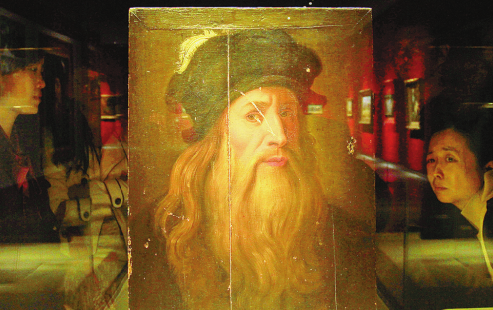Da Vinci's alleged self-portrait is among masters' works on display at Shandong Museum, report Zhao Ruixue and Sun Ye.
 |
| Visitors have a closer look at the Lucan Portrait of Leonardo da Vinci at Shandong Museum. |
Zhu Jingyin, a student who majored in arts at Yibin College, says the European Classics Exhibition is the most valuable class he has ever taken.
A part of the ongoing 10th China Art Festival hosted by Shandong province, the exhibition is showcasing 354 works of world-famous artists including Leonardo da Vinci, Michelangelo Buonarroti, Pablo Picasso and Salvador Dali.
These works include oil paintings, sculptures and manuscripts.
"I had spent a whole day here (at the exhibition), obsessed with these great works. Classes and books will never give me such inspiration as I get from these real works," says Zhu, who traveled 28 hours by train to Jinan, where the exhibition is held.
One of the works is the Lucan Portrait of Leonardo da Vinci, believed to be a self-portrait by the master.
"The portrait has been proved to be the only recognized self-portrait of Da Vinci," says Vincenzo Sanfo, chairman of the Italian Art and Cultural Center and the artistic director of this exhibition.
The painting was discovered in 2009 by art historian and gallery owner Nicola Barbatelli in southern Italy, in the private collection of an old aristocratic family. Its owners originally thought it was a portrait of Galileo.
Unlike the other works that hang on the walls, the portrait is locked in a separate display window.
"It is the portrait's debut in China and probably the last time (it will be exhibited)," says Sanfo.
Painted in tempera grassa on a wooden panel, the 60cm-by-40cm portrait depicts a man in three-quarter view, with high nose, long beard and wearing a dark hat. On the hat there is a small curled white feather. A crack and several areas of abrasion to the surface of the painting can easily be seen.
"Analysis has shown the pigment used for the feather is different from the pigment used in other parts of the painting," says Sanfo.
Sanfo says the feather will be removed after the painting returns to Italy. Experts will meet in Paris in a few months to decide whether other damage like the abrasion shall be repaired. Three areas on the back of the panel marked with the numbers "1", "2" and "3" indicate wood materials have been taken from the three places for analysis.
